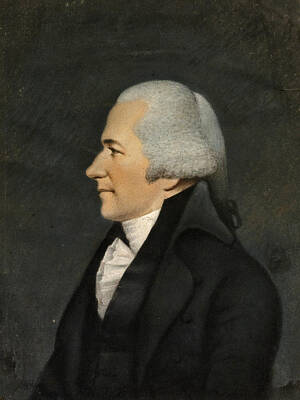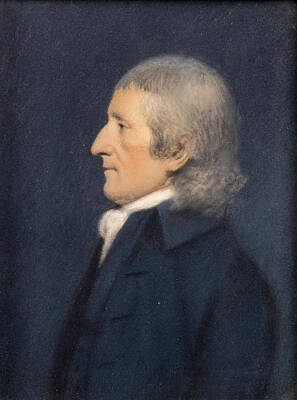James Sharples
Profile Portrait Of George Washington
Profile Portrait Of Alexander Hamilton
James Sharples (1751 or 1752 in Lancashire – 26 February 1811 in New York City [1]) was an English portrait painter and pastelist, who moved to the United States in 1794. He first exhibited at the Royal Academy in 1779.
Life
George Washington
Classic profile on Postage Issue of 1895, face of engraving taken from a portrait by James Sharples, 1751.[2]
James was first intended for the Catholic priesthood, but became an artist instead.[3] Sharples headed a family of successful portrait artists, including his third wife Ellen Sharples. He had four children: George by his first wife; Felix Thomas Sharples from his second marriage (c. 1786- after 1823); and James Sharples Jr.(c. 1788-1839) and daughter Rolinda Sharples (1793–1838) with this third wife, Ellen. Felix, James Jr. and Rolinda joined the family enterprise at ages 17, 15, and 13 respectively.[4] Before marrying Ellen Wallace, James had been active in Bristol, Liverpool and Bath, where he taught drawing.[5] Ellen was a lady of French extraction who had relations in America. The family left for the United States in 1796, but, according to Ellen's diaries, their ship fell into the hands of the French, and for seven months the family spent time in Brest, near Cherbourg. Landing in New York, James quickly became popular for his small portraits in pastel and his miniatures.[6] From 1796 to 1801 he worked mainly in Philadelphia and New York, securing portrait commissions. The family traveled throughout New England region as itinerant portrait painters, looking for work and making inexpensive copies from the originals portraits they had made of popular and well-known figures, such as George Washington and James Madison.
The Sharples family built both a reputation for accurate portraits and a modest fortune. As a viable alternative to the larger, formal oil portraits of Gilbert Stuart and Jonathan Trumbull, for example, their small-scale pastels made a major contribution to the growing Federal portrait industry.[7]
After encountering problems with the lease of their house in Bath in 1801, the Sharples returned to England. The war between France and Britain delayed the family's return to the United States. Felix and James returned in 1806, and their parents and sister Rolinda followed in 1809. After James Sharples's death of heart trouble during an extremely cold winter in 1811, the family returned to England.[8] Only Felix elected to remain behind.
Personal papers
Letters, legal papers, bank and account books relating to James and Ellen Sharples and their family are held at Bristol Archives (Ref. 15395) (online catalogue).
Paintings
Carlos Martínez de Irujo y Tacón, Pastel attributed to James Sharples, Sr.
Portraits of a man and a woman, by James Sharples
James Sharples established his career in America in 1794 by offering to make profiles of local and national politicians. He then used the original portraits to show as samples to new clients or to make copies of the originals. During this time, copies of portraits of famous people were popular, though the competition among artists was intense, and many had to travel in order to find customers.[9] Sharples often used a physiognotrace, a mechanical drawing aid, to record an exact profile, which he kept for his personal collection. He would then copy these originals for resale.[10] He also painted three-quarter bust-size pastel portraits with a delicate, precise touch. His color palette was predominantly black, white, and grey. The skin was rendered in flesh tones and the backgrounds were generally blue. "The mainstay of Sharples's business was making replicas from the life portrait he made of Washington, just as Gilbert Stuart's staple was making replicas in oil of his portrait of the first president."[11] The Sharples charged $15 per profile and $25 for a full-face view.[12]
Sharple's subjects included George Washington, Thomas Jefferson, Hester Thrale, Joseph Priestley, James Madison, Dolley Madison, and John Adams. Sharples' family members all took part in duplicating the original portraits, which sometimes made it hard to distinguish the original from the duplicate.
According to the Re-identification of a Portrait by James Sharples, author David Meschutt re-identified the portrait labeled as General James Wilkinson in the Independence National Historical Park. Meschutt assessed that the unidentified figure in the portrait represents a soldier. Based on this information, Meschutt was able to narrow down the potential names of the figure with a Sharples collection catalogue. At the beginning of the process of comparing the portrait to the catalogue, Meschutt identified the figure as General William Hull. The identification process is reaffirmed by similarity between the first portraiture and the portraiture of General Hull in Worcester Art Museum. Further, John C. Milley proved the identity of the portraiture through a tracing of photography from the Independence painting.[13]
Royal Academy Paintings
From the listing in a book of The Royal Academy Exhibitors one can see that James Sharples exhibited his works before he moved to America. The following is a partial listing of his paintings.[14]
1779 - Two paintings: A lady; Two gentlemen
1782 - Portrait of a lady of quality; nobleman; crayons (Duke of Northumberland, Walpole)
1783 - Portrait of a lady; a gentleman; a lady; fruit girl in the wind
1785 - A Newcastle lady in the character of Spring; portrait of a young lady; gentleman; lady
Bibliography
L. H. Cust, ‘Sharples, James (1751/2–1811)’, rev. Annette Peach, Oxford Dictionary of National Biography, Oxford University Press, 2004 http://www.oxforddnb.com/view/article/25240, accessed 11 June 2007
Metz, Kathryn. "Ellen and Rolinda Sharples: Mother and Daughter Painters", Woman's Art Journal, Vol. 16, No. 1 (Spring - Summer, 1995), pp 3–11.
The Sharples Family and Legal Papers: 1794 - 1854, Dr. Diane Waggoner
Memorials of Washington and of Mary, his mother, and Martha, his wife, from letters and papers of Robert Cary and James Sharples, Scribners and Sons, 1887
References
http://www.answers.com/topic/james-sharples-2
National Portrait Gallery: http://www.npg.si.edu/exh/gw/gwsharp.htm
Bryan's dictionary of painters and engravers https://archive.org/stream/bryansdictionary05bryauoft/bryansdictionary05bryauoft_djvu.txt
Metz, Kathryn. "Ellen and Rolinda Sharples: Mother and Daughter Painters", Woman's Art Journal, Vol. 16, No. 1 (Spring - Summer, 1995), p 1.
http://www.microform.co.uk/guides/R97579.pdf The Sharples Family and Legal Papers: 1794 - 1854, Dr. Diane Waggoner
Bryan's dictionary of painters and engravers https://archive.org/stream/bryansdictionary05bryauoft/bryansdictionary05bryauoft_djvu.txt
Metz, p. 1
Metz, p 4
Waggoner, pp 6-7
The Met Museum http://www.metmuseum.org/toah/hd/amdr/ho_08.144.htm
Virginia Historical Society http://www.vahistorical.org/gwportrait.htm
Waggoner, pp 6-7
"Re-identification of a portrait by James Sharples". The American Art Journal.
The Royal Academy of the Arts: Exhibitors, pp 92-93 https://archive.org/stream/royalacademyofar07grav#page/92/mode/2up
----
Fine Art Prints | Greeting Cards | Phone Cases | Lifestyle | Face Masks | Men's , Women' Apparel | Home Decor | jigsaw puzzles | Notebooks | Tapestries | ...
----
Artist
A - B - C - D - E - F - G - H - I - J - K - L - M -
N - O - P - Q - R - S - T - U - V - W - X - Y - Z
Retrieved from "http://en.wikipedia.org/"
All text is available under the terms of the GNU Free Documentation License





